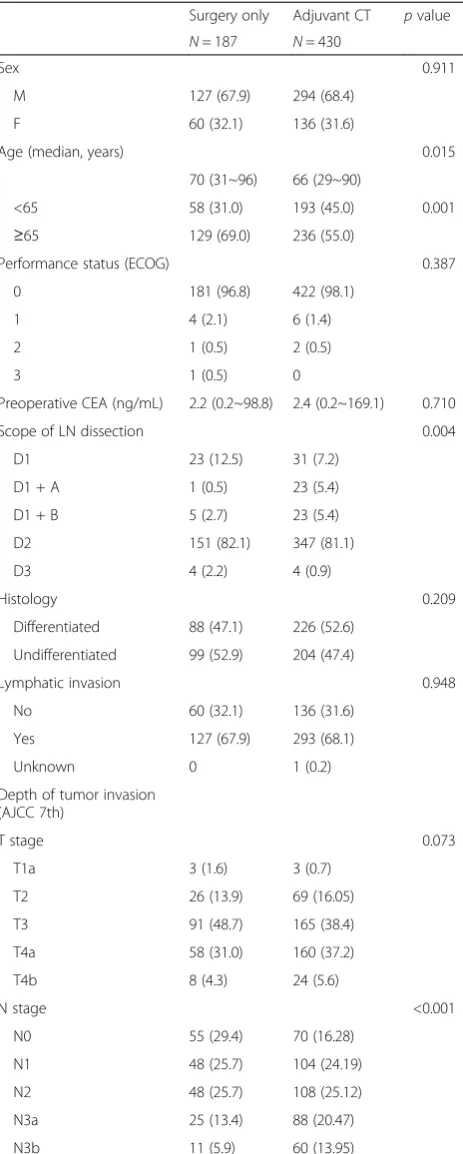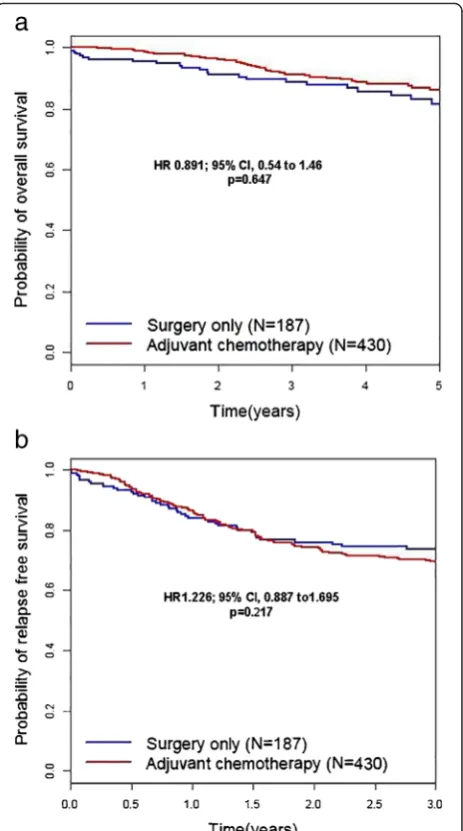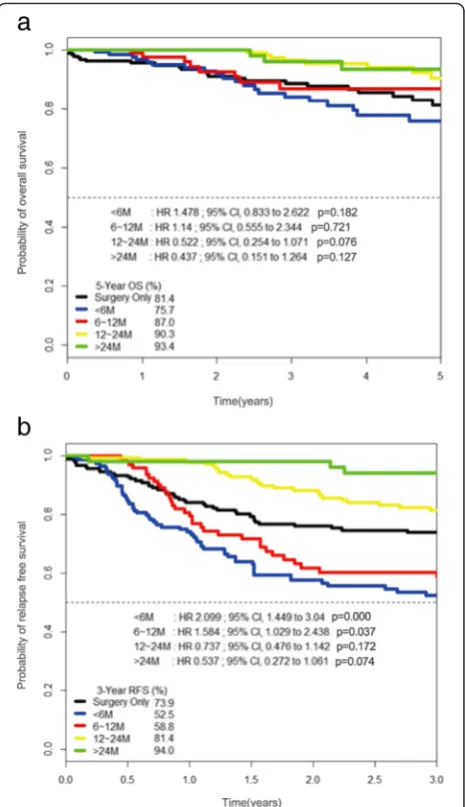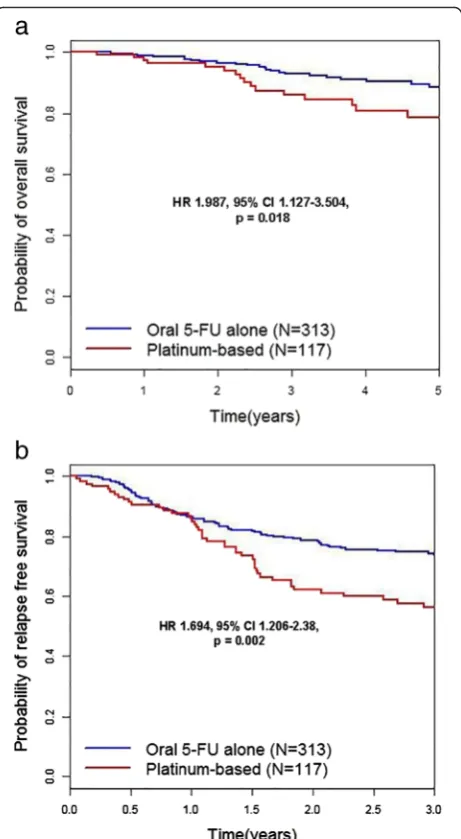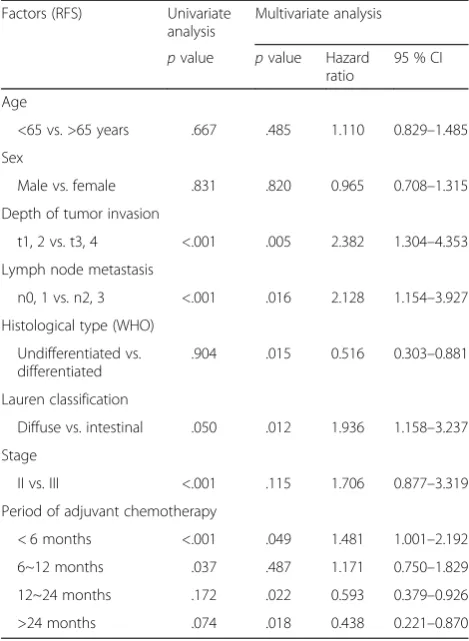R E S E A R C H
Open Access
The association between the duration
of fluoropyrimidine-based adjuvant
chemotherapy and survival in stage II or III
gastric cancer
Seong-Geun Kim
1,3and Sun-Hwi Hwang
2,3,4*Abstract
Background:This study was conducted to propose the optimal duration of fluoropyrimidine-based adjuvant chemotherapy consisting of fluoropyrimidine derivatives alone or combined with intravenous platinum for stage II or III gastric cancer (GC).
Methods: We analyzed retrospectively the data from 2219 patients with histologically confirmed adenocarcinoma in the stomach, who underwent a curative gastrectomy with lymphadenectomy from 2005 to 2012. Five-year overall survival (OS) and 3-year relapse-free survival (RFS) were analyzed according to the duration of fluoropyrimidine-based adjuvant chemotherapy.
Results:Data from 617 patients with stage II or III GC were analyzable; 187 patients (30.3 %) were treated with surgery alone, while 430 patients (69.7 %) were treated with postoperative adjuvant chemotherapy. The duration of adjuvant chemotherapy was less than 6 months [group 1] in 147 patients (34.2 %), 6 months to less than 12 months [group 2] in 94 patients (21.9 %), 1 year to less than 2 years [group 3] in 139 patients (32.3 %), and over 2 years [group 4] in 50 patients (11.6 %). The 5-year OS in groups 1, 2, 3, and 4 was 75.7, 87, 90.3, and 93.4 %, respectively, while 3-year RFS was 52.5, 58.8, 81.4, and 94.0 %, respectively.
Conclusions:In this retrospective study, we did not demonstrate any significant improvement in OS and RFS by longer periods of fluoropyrimidine-based adjuvant chemotherapy in stage II or III GCs. Further prospective randomized studies are needed.
Keywords:Fluoropyrimidine based, Survival, Gastric cancer
Background
According to the estimated incidence, mortality and worldwide prevalence data for 2012 from the Inter-national Agency for Research on Cancer, gastric cancer (GC) is the fifth most common malignancy in the world. With nearly 1 million cases per annum, it is the third leading cause of cancer-related death in both sexes worldwide [1]. In addition, GC is the second most common malignancy in Asia and more than half of
new GCs occur in Eastern Asia [2]. At present, adju-vant chemotherapy or chemoradiotherapy after surgi-cal resection of GC is a reasonable option because high rates of locoregional or distant recurrences have been reported [3–6].
For the treatment of gastric and gastroesophageal junc-tion adenocarcinoma, the Intergroup trial 0116 (INT-0116) in 2001 showed the first high-level evidence for improved survival from adjuvant therapy in GC [7]. Now-adays, extensive (D2) lymph-node dissection is recom-mended because the adequacy of surgical resection is an important issue. However, only 10 % of patients under-went D2 dissection, while 36 % had D1 dissection, and 54 % had D0 lymphadenectomy in this trial. The median * Correspondence:hwangsh@pusan.ac.kr
2
Department of Surgery, Pusan National University Yangsan Hospital, Beomeo-ri Mulgeum-eup, Yangsan, Gyeongnam 626-770, South Korea 3Research Institute for Convergence of Biomedical Science and Technology,
Pusan National University Yangsan, Yangsan, South Korea Full list of author information is available at the end of the article
overall survival (OS) in the surgery-only group was 27 months, as compared to 36 months in the adjuvant chemoradiotherapy group. Since then, postoperative che-moradiotherapy has become the standard treatment after a curative resection in the USA. In 2006, the Medical Research Council Adjuvant Gastric Infusional Chemo-therapy (MAGIC) trial randomly assigned patients with resectable stomach, esophagogastric junction, or lower esophagus cancer to either perioperative chemotherapy following surgery (250 patients) or surgery alone (253 patients). The primary endpoint was OS. Compared to the surgery group (23 %), the perioperative chemotherapy group (36 %) had a higher likelihood of 5-year overall sur-vival. As the MAGIC trial shows a survival benefit, in Europe, perioperative chemotherapy with epirubicin, cis-platin, and 5-fluorouracil (ECF) has become the standard of care following curative resection [4].
S-1 has been developed mainly in Japan because the pharmaceutical company producing S-1 is a domestic Japanese company, and there are sufficient numbers of patients with gastric cancer in Japan for clinical trials. Phase II trials of S-1 monotherapy (40 mg/m2, twice a day, on days 1–28, every 6 weeks) were conducted in Japan [8]. In 1999, the Japanese government approved this drug for treating gastric cancer on the basis of the results of the two domestic phase II trials [9]. S-1 is a novel oral agent containing tegafur, a prodrug of 5-fluorouracil (5-FU), and two biochemical modulators of 5-FU including 5-chloro-2,4-dihydroxypyridine and po-tassium oxonate. 5-Chloro-2,4-dihydroxypyridine increases the pharmacological action of 5-FU by inhibiting dihy-dropyrimidine dehydrogenase. Potassium oxonate, which localizes to the mucosal cells of the gastrointestinal (GI) tract after oral administration, reduces GI toxicity by sup-pressing the activation of 5-FU in the GI tract. In Japan, the patients with stage II or III GC who underwent gas-trectomy plus extended (D2) lymph node dissection were randomly assigned to either the surgery with S-1 adjuvant therapy group or to the surgery alone group. The primary endpoint was OS. The 3-year OS rate was 80.1 % in the S-1 group and 70.1 % in the surgery-only group. The hazard ratio (HR) for death in the S-1 group compared to the surgery-only group was 0.68. The OS rate at 5 years was 71.7 % in the S-1 group and 61.1 % in the surgery-only group. The rate of relapse-free survival (RFS) at 3 years was 72.2 % in the S-1 group and 59.6 % in the surgery-only group. The 5-year RFS rate was 65.4 % in the S-1 group and 53.1 % in the surgery-only group [5]. The CLASSIC study was an open-label, phase 3, randomized controlled trial undertaken in 37 centers in South Korea, China, and Taiwan. Patients with stage II, IIIA, and IIIB GC who had undergone curative D2 gastrectomy were randomly assigned to either adjuvant chemotherapy with capecitabine plus
oxaliplatin (XELOX) for 6 months or surgery only. The primary endpoint was 3-year disease-free survival (DFS). The 3-year DFS was 74 % in the chemotherapy after surgery group and 59 % in the surgery-only group. The 5-year OS rate was 78 % in the XELOX group and 69 % in the surgery alone group. The 5-year DFS rate was 68 % in the XELOX group and 53 % in the surgery alone group. In this study, more than half of the patients who received chemotherapy had peripheral neuropathy, which is a cu-mulative, dose-related toxic effect associated with oxali-platin, but grade 3 or 4 events were infrequent [6].
Among the regimens mentioned above, most random-ized prospective studies have evaluated the effects of chemotherapy over periods ranging from 6 to 12 months. Postoperative FU-based oral chemotherapy, such as S-1 for 1 year or capecitabine plus oxaliplatin for 6 months, is proven as the effective treatments for localized GC after D2 gastrectomy [5, 6]. However, it is difficult to say which regimens are better for adjuvant chemotherapy of GC because they have similar efficacies and different tox-icities. Although only appropriately designed and powered randomized clinical trials can address the optimal dur-ation of adjuvant chemotherapy, because of the relatively high recurrence rate in GC patients, ethical concerns are likely to prevent any prospective study of the optimal dur-ation of adjuvant treatment from being undertaken [10].
Consequently, we wanted to undertake a retrospective analysis exploring the correlation between adjuvant chemo-therapy duration and OS or RFS in advance of conducting a randomized prospective study.
Methods
Patients
The data were collected from 2219 patients with histologi-cally confirmed adenocarcinoma in the stomach, who underwent curative gastrectomy with lymphadenectomy from 2005 to 2012 in Pusan National University Hospital. The baseline patient characteristics are shown in Table 1.
Study design and treatment
This study is a retrospective study for evaluating the opti-mal duration of fluoropyrimidine-based adjuvant chemo-therapy in patients who had initially operable stage II or III GC. The adjuvant chemotherapy consisted of fluoro-pyrimidine derivatives (doxifluridine, UFT, S-1, capecit-abine) alone or combined with platinum (cisplatin or oxaliplatin). Patients with stage II or III GC were divided into five stages according to theAmerican Joint Commit-tee on Cancer staging manual,7th edition[Fig. 1] [11].
Statistical methods
follow-up visit. Secondary analysis included 3-year RFS, which was calculated as the time from surgery to the time of recurrence. Univariate and multivariate analyses using a Cox proportional hazard regression model were carried out, and hazard ratios (HR) were estimated with 95 % confidence interval (95 % CI) limits. Both uni-variate and multiuni-variate analyses were conducted to establish the association between prognosis and age, sex, depth of tumor invasion, lymph node metastasis, histological type, stage, and the duration of adjuvant chemotherapy. Survival curves were generated by the Kaplan–Meier method. Ap value of less than 0.05 was considered significant. All analyses were performed using SPSS for Windows, version 21.0 (SPSS Inc., Chicago, IL, USA), and R software, version 3.1.1 (R Foundation for Statistical Computing).
Results
After patients with any unanalyzable conditions were excluded, 617 patients with stage II or III GC were en-rolled. Due to patients’refusal or postoperative morbid-ity, 187 patients (30.3 %) were treated with surgery alone; 430 patients (69.7 %) were treated for diverse Table 1Patient and tumor characteristics
Surgery only Adjuvant CT pvalue
N= 187 N= 430
Sex 0.911
M 127 (67.9) 294 (68.4)
F 60 (32.1) 136 (31.6)
Age (median, years) 0.015
70 (31~96) 66 (29~90)
<65 58 (31.0) 193 (45.0) 0.001
≥65 129 (69.0) 236 (55.0)
Performance status (ECOG) 0.387
0 181 (96.8) 422 (98.1)
1 4 (2.1) 6 (1.4)
2 1 (0.5) 2 (0.5)
3 1 (0.5) 0
Preoperative CEA (ng/mL) 2.2 (0.2~98.8) 2.4 (0.2~169.1) 0.710
Scope of LN dissection 0.004
D1 23 (12.5) 31 (7.2)
D1 + A 1 (0.5) 23 (5.4)
D1 + B 5 (2.7) 23 (5.4)
D2 151 (82.1) 347 (81.1)
D3 4 (2.2) 4 (0.9)
Histology 0.209
Differentiated 88 (47.1) 226 (52.6)
Undifferentiated 99 (52.9) 204 (47.4)
Lymphatic invasion 0.948
No 60 (32.1) 136 (31.6)
Yes 127 (67.9) 293 (68.1)
Unknown 0 1 (0.2)
Depth of tumor invasion (AJCC 7th)
T stage 0.073
T1a 3 (1.6) 3 (0.7)
T2 26 (13.9) 69 (16.05)
T3 91 (48.7) 165 (38.4)
T4a 58 (31.0) 160 (37.2)
T4b 8 (4.3) 24 (5.6)
N stage <0.001
N0 55 (29.4) 70 (16.28)
N1 48 (25.7) 104 (24.19)
N2 48 (25.7) 108 (25.12)
N3a 25 (13.4) 88 (20.47)
N3b 11 (5.9) 60 (13.95)
Table 1Patient and tumor characteristics(Continued)
Stage 0.002
IIA 74 (39.6) 102 (23.72)
IIB 35 (18.7) 89 (20.7)
IIIA 27 (14.4) 67 (15.58)
IIIB 24 (12.8) 92 (21.39)
IIIC 27 (14.4) 78 (18.60)
CTchemotherapy
durations with various fluoropyrimidine-based adjuvant chemotherapy regimens. The numbers of male patients were 294 (68.4 %) and the numbers of female patients were 136 (31.6 %), and the numbers of patients below the age of 60, between the ages of 60 and 70, and over the age of 70 who underwent adjuvant chemotherapy were 118 (27.5 %), 125 (29.1 %), and 186 (43.4 %), respectively. The median follow-up duration of OS was 42.2 months (mean = 41.9, SD = 26.2); the median follow-up duration of RFS was 14.5 months (mean = 19.4, SD = 16.7).
The 5-year OS rates for the adjuvant chemotherapy and surgery-only groups were 86.0 and 81.4 %, respect-ively. The hazard ratio (HR) for death in the adjuvant chemotherapy group as compared to the surgery-only group was 0.891, with a 95 % confidence interval (CI) of 0.54–1.46 (p= 0.647). However, the 3-year RFS rate for the adjuvant chemotherapy group was 69.3 % compared to 73.9 % in the surgery-only group. The HR for relapse in the adjuvant chemotherapy group was 1.226 (95 % CI 0.887–1.695,p= 0.217) [Fig. 2].
The duration of adjuvant chemotherapy was less than 6 months [group 1] in 147 patients (34.2 %), 6 months to less than 12 months [group 2] in 94 patients (21.9 %), 1 year to less than 2 years [group 3] in 139 patients (32.3 %), and over 2 years [group 4] in 50 patients (11.6 %) in Table 2.
Adjuvant chemotherapy regimens for GC in this study were divided into seven categories depending on the administration method, which included intravenous (IV), per oral (PO), or a combination of IV and PO methods. The most commonly used drugs were doxifluridine, UFT, and S-1 in order of the decreasing frequency. The median cycles of the regimens are also listed in Table 3. The distribution of patients according to durations of chemotherapy and TNM stages is shown in Table 4.
For subgroup analysis, the 5-year OS and 3-year RFS rates were analyzed according to the duration of adjuvant chemotherapy. The reference category of Cox regression analysis in Fig. 3a, b is no adjuvant treatment or surgery-only group. Five-year OS rates for groups 1, 2, 3, and 4 were 75.7 % (HR 1.478, 95 % CI 0.833–2.62, p= 0.182), 87 % (HR 1.140, 95 % CI, 0.555–2.344,p= 0.721), 90.3 % (HR 0.522, 95 % CI 0.254–1.071, p= 0.076), and 93.4 % (HR 0.437, 95 % CI 0.151–1.264, p= 0.127), respectively. The 3-year RFS rates for groups 1, 2, 3, and 4 were 52.5 % (HR 2.099, 95 % CI 1.449–3.040, p= 0.000), 58.8 % (HR 1.584, 95 % CI 1.029–2.438,p= 0.037), 81.4 % (HR 0.737, 95 % CI 0.476–1.142, p= 0.172), and 94.0 % (HR 0.537, 95 % CI 0.272–1.061, p= 0.074), respectively [Fig. 3]. Compared to long-term administration of oral 5-FU chemotherapy alone, regimens combined with platinum had a hazardous effect on OS (HR 1.987, 95 % CI 1.127– 3.504,p= 0.018) and RFS (HR 1.694, 95 % CI 1.206–2.38,
Fig. 2Kaplan–Meier curves for overall survival (a) and relapse-free survival (b). The rates of overall survival in the adjuvant chemotherapy and surgery-only groups are 86.0 and 81.4 %, respectively, while the rates of relapse-free survival are 69.3 and 73.9 %, respectively. The hazard ratio for death in the adjuvant chemotherapy group as compared to the surgery-only group is 0.891 (95 % confidence interval 0.54–1.46,
p= 0.647). The hazard ratio for relapse in the adjuvant chemotherapy group is 1.226 (95 % confidence interval 0.887–1.695,p= 0.217).pvalues were calculated using the stratified log-rank test
Table 2The proportions according to the lengths of chemotherapy
Durations of chemotherapy n(%)
<6 M 147 (34.2 %)
6~12 M 94 (21.9 %)
12~24 M 139 (32.3 %)
>24 M 50 (11.6 %)
p= 0.002) [Fig. 4]. p values were calculated using the stratified log-rank test.
Multivariate analyses of OS revealed the prognostic significance of the depth of tumor invasion, lymph node metastasis, and 12- to 24-month duration of adjuvant chemotherapy in Table 5. Multivariate analyses of RFS also showed the prognostic significance of the depth of tumor invasion, lymph node metastasis, histological type, and periods of adjuvant chemotherapy over 12 and 24 months in Table 6.
Discussion
In order to improve OS or RFS with adjuvant chemo-therapy, both duration and cumulative dose intensity of adjuvant treatment are as important as the regimen. As the optimal length of time for adjuvant chemotherapy has not been established, if adjuvant chemotherapy does not adversely affect patients, continuation of chemother-apy over the planned period should be considered. There-fore, in Japan, a retrospective study was conducted to evaluate the effectiveness of oral anti-cancer drugs (for 2 years) as postoperative adjuvant chemotherapy in GC patients [12]. Authors divided the 20 years chronologically into the UFT (5-FU analog, tegafur combined with uracil in a ratio of 1:4, Taiho Pharmaceutical Co. Ltd., Tokyo, Japan) term (1989–2003) and the S-1 term (2004–2008). The patients from each term were then divided into three
groups according to the length of drug administration, namely, the surgery-alone group, the 1-year group, and the 2-year group. The survival time of the 2-year group Table 3The names and median cycles of regimens used as
adjuvant chemotherapy
Regimens Number Percent Cycles
Doxifluridine (D1–28) q 4w 205 47.7 19.9
UFT (D1–28) q 4w 57 13.3 11.9
S-1 (D1–28) q 6w 51 11.9 5.0
Capecitabine (D1–14) + cisplatin (D1) q 3w 48 11.2 6.8
5-FU (D1–5) + cisplatin (D1) q 3w 44 10.2 5.7
S-1 (D1–14) + cisplatin (D1) 18 4.2 5.7
Oxaliplatin (D1) + leucovorin (D1–2) + 5-FU (D1–2) q 2w
7 1.6 12.6
nnumber of patients,qevery,wweeks,Dday
Table 4The distribution of patients according to durations of chemotherapy and TNM stages
Stage (TNM) Durations of chemotherapy
<6 M 6~12 M 12~24 M >24 M
IIA 25 (17.0 %) 13 (13.8 %) 46 (33.0 %) 18 (36.0 %)
IIB 21 (14.3 %) 21 (22.3 %) 34 (24.4 %) 13 (26.0 %)
IIIA 24 (16.3 %) 14 (14.9 %) 22 (15.8 %) 7 (14.0 %)
IIIB 39 (26.5 %) 21 (22.3 %) 23 (16.5 %) 9 (18.0 %)
IIIC 38 (25.9 %) 25 (26.6 %) 14 (10.0 %) 3 (6.0 %)
Numbers in parenthesis represent the row percentages Mmonths
Fig. 3Kaplan–Meier curves for overall survival (a) and relapse-free survival (b) according to adjuvant chemotherapy durations in patients with gastric cancer. The duration of adjuvant chemotherapy was less than 6 months [group 1] in 147 patients (34.2 %), from 6 months to less than 12 months [group 2] in 94 patients (21.9 %), from 1 year to less than 2 years in [group 3] 139 patients (32.3 %), and over 2 years [group 4] in 50 patients (11.6 %). The reference category of Cox regression analysis in Fig. 3a, b is no adjuvant treatment or surgery-only group. Five-year OS rates for groups 1, 2, 3, and 4 were 75.7 % (HR 1.478, 95 % CI 0.833–2.62,p= 0.182), 87 % (HR 1.140, 95 % CI, 0.555–2.344,p= 0.721), 90.3 % (HR 0.522, 95 % CI 0.254–1.071,p= 0.076), and 93.4 % (HR 0.437, 95 % CI 0.151–1.264,p= 0.127), respectively. The 3-year RFS rates for groups 1, 2, 3, and 4 were 52.5 % (HR 2.099, 95 % CI 1.449–3.040,p= 0.000), 58.8 % (HR 1.584, 95 % CI 1.029–2.438,p= 0.037), 81.4 % (HR 0.737, 95 % CI 0.476–1.142,
was better than that of the surgery-alone group, not only in the UFT term, but also in the S-1 (p= 0.0224). Longer RFS was evident in the S-1 term, especially for the 2-year group (p= 0.0110), and a multivariate analysis showed that both the stage of the cancer and 2 years of postoperative adjuvant chemotherapy were independent factors predict-ive of prolonged survival. Not only in the retrospectpredict-ive study but also in the randomized trial of S-1 for gastric cancer (ACTS-GC), the duration of adjuvant chemother-apy was proportional to the overall survival. Among the
517 patients in the safety population who received S-1, the persistence rate of S-1 treatment for 12 months was just 65.8 %. Besides, the dose was decreased in half of the patients who received treatment for 12 months [5]. The reasons for treatment withdrawal were patient refusal or investigator decisions due to adverse events or complica-tions, metastasis, relapse, or presence of another cancer [5, 13]. For another examples, the recurrence of GIST is common in the initial years following discontinuation of adjuvant imatinib treatment. So more than 12 months could be reasonable for adjuvant treatment of patients with a highly estimated risk of GIST recurrence after sur-gery [14]. Joensuu and colleagues [15] investigated and concluded that 3 years of adjuvant imatinib administration improved RFS and OS in GIST patients with a high risk of recurrence compared to 1 year of imatinib. When it comes to women with estrogen receptor-positive breast cancer, continuing tamoxifen for 10 years rather than stopping at 5 years produces a further reduction in re-currence and mortality, particularly after 10 years [16].
However, this opinion is likely to evoke strong oppos-ition from other studies. Colleoni M. et al. reported that Fig. 4Kaplan–Meier curves for overall survival (a) and relapse-free
survival (b) in the oral 5-fluorouracil alone group (n= 313) versus the platinum-based group (n= 117). The oral 5-fluorouracil-alone group has better overall survival compared to the platinum-based group (hazard ratio 1.987, 95 % confidence interval 1.127–3.504,p= 0.018) and relapse-free survival (hazard ratio 1.694, 95 % confidence interval 1.206–2.38,p= 0.002).pvalues were calculated using the stratified log-rank test
Table 5Univariate and multivariate analyses of prognostic factors for overall survival according to the period of adjuvant chemotherapy
Factors (OS) Univariate
analysis
Multivariate analysis
pvalue pvalue Hazard ratio
95 % CI
Age
<65 vs. >65 years .154 .094 0.663 0.410–1.073
Sex
Male vs. female .596 .302 0.757 0.447–1.284
Depth of tumor invasion
t1, 2 vs. t3, 4 <.001 .014 5.176 1.390–19.269
Lymph node metastasis
n0, 1 vs. n2, 3 <.001 .019 4.819 1.288–18.022
Histological type (WHO)
Undifferentiated vs. differentiated
.348 .703 0.547 0.362–1.985
Lauren classification
Diffuse vs. intestinal .170 .556 1.271 0.572–2.825
Stage
II vs. III <.001 .851 1.142 0.286–4.559
Period of adjuvant chemotherapy
<6 months .182 .374 0.877 0.476–1.616
6~12 months .721 .267 0.655 0.310–1.383
12~24 months .076 .005 0.347 0.167–0.726
>24 months .127 .061 0.358 0.123–1.047
3 cycles of cyclophosphamide/methotrexate/fluorouracil (CMF) would be sufficient for women aged under 40 with hormone receptor positive, potentially endocrine responsive node-positive disease if CMF were followed by effective endocrine therapy. For women of any age with tumors that do not express any steroid hormone receptors (ER-absent) (a relatively small subgroup of patients), the issue of adjuvant chemotherapy duration requires further study, but this results do not suggest that adjuvant CMF can safely be reduced to 3 cycles in these women [17]. With regard to colorectal cancer, Des Guetz G. and his colleagues performed a meta-analysis of all RCTs comparing two durations of 5-FU-based adju-vant treatment, 6 months versus 9 to 12 months. Shorter duration of chemotherapy (3–6 months) compared with longer duration (9–12 months) was not associated to poorer RFS (RR = 0.96, 95 % CI 0.90–1.02) and OS (RR = 0.96, 95 % CI 0.91–1.02). This meta-analysis confirmed that adjuvant chemotherapy of CRC should not last for more than 6 months [18].
Besides heterogeneous regimens and inadequate med-ical records, this study has so many difficulties in being
comprehended because the data derived from changes in chemotherapy schedule or fluoropyrimidine dosage were not directly connected to compliance in our patients. The reasons why patients were treated with no chemo-therapy or with 6–12 to 24 months of chemochemo-therapy and why patients were treated with single agent or com-bination were presumed to be are because of physician’s choice or intolerance to chemotherapy in patients with adverse reactions. Toxicity profiles were not recorded schematically in most patients. However, unbearable adverse events like nausea, vomiting, and peripheral neuropathy were more common in platinum-combined regimens, which were not administered for more than 6 months traditionally. No patient received 1 or 2 years of platinum-based regimen was found in this study. On the other hand, most of single oral FU-based chemo-therapy regimens were administered for more than 6 months, as pointed out in the introduction, long-term oral administration of fluoropyrimidines such as doxi-fluridine or tegafur was commonly used as adjuvant chemotherapy for gastric cancer because the optimal period or optimal total doses of fluoropyrimidines have been rarely studied.
In the results, we found that the 3-year RFS rate is lower in the adjuvant chemotherapy group than in the surgery-only group. Perhaps, it seems like main reason that relatively more patients with high nodal stage were included in the adjuvant chemotherapy group than in the surgery only group as shown in Table 1.
There are still unresolved issues. Firstly, adjuvant chemo-therapy does not prolong OS [Fig. 2a] and RFS [Fig. 2b] over surgery alone. Secondly, OS and RFS is significantly lower in the <6, 6-12 months of adjuvant chemotherapy group than in surgery only group [Fig. 3a-b]. The most likely explanation of this phenomenon is that stage III pa-tients with poor prognosis are located dominantly in the left lower quadrant area of Table 3. Thirdly, 12-24 months of adjuvant chemotherapy significantly prolong OS and RFS at multivariate analysis, not at univariate analysis. Unfortunately, we cannot give explicit answers to these complex statistical issues except that retrospective data ana-lysis are susceptible to bias in data selection and it may show associations among variables, but rarely establishes causal relationships [19].
Conclusions
By this retrospective analysis, the authors did not verify that the prolonged administration of oral fluoropyrimidine derivatives as postoperative adjuvant chemotherapy could lead to a favorable outcome for stage II and III GC patients. Therefore, we propose further prospective randomized studies to determine the appropriate fluoropyrimidine-based regimens and optimal duration of adjuvant chemo-therapy for higher OS and RFS in GC patients.
Table 6Univariate and multivariate analyses of prognostic factors for relapse-free survival according to the period of adjuvant chemotherapy
Factors (RFS) Univariate
analysis
Multivariate analysis
pvalue pvalue Hazard ratio
95 % CI
Age
<65 vs. >65 years .667 .485 1.110 0.829–1.485
Sex
Male vs. female .831 .820 0.965 0.708–1.315
Depth of tumor invasion
.904 .015 0.516 0.303–0.881
Lauren classification
Diffuse vs. intestinal .050 .012 1.936 1.158–3.237
Stage
II vs. III <.001 .115 1.706 0.877–3.319
Period of adjuvant chemotherapy
< 6 months <.001 .049 1.481 1.001–2.192
6~12 months .037 .487 1.171 0.750–1.829
12~24 months .172 .022 0.593 0.379–0.926
>24 months .074 .018 0.438 0.221–0.870
Abbreviations
5-FU:5-fluorouracil; CRC: colorectal cancer; GC: gastric cancer; RCT: randomized controlled trial; RR: relative risk; SD: standard deviation.
Competing interests
The authors declare that they have no competing interests.
Authors’contributions
SHH designed the research and collected the data. SGK analyzed the data and wrote the manuscript. SHH reviewed and edited the manuscript finally. Both authors read and approved the final manuscript.
Acknowledgements
This study was supported by the Research Institute for Convergence of Biomedical Science and Technology, Pusan National University Yangsan Hospital. The English in this document has been checked by at least two professional editors, both native speakers of English.
Author details
1Department of Internal Medicine, Pusan National University Yangsan
Hospital, Beomeo-ri Mulgeum-eup, Yangsan, Gyeongnam 626-770, South Korea.2Department of Surgery, Pusan National University Yangsan Hospital, Beomeo-ri Mulgeum-eup, Yangsan, Gyeongnam 626-770, South Korea. 3Research Institute for Convergence of Biomedical Science and Technology,
Pusan National University Yangsan, Yangsan, South Korea.4Division of Gastric Surgery, Department of Surgery, Pusan National University Yangsan Hospital, Beomeo-ri Mulgeum-eup, Yangsan, Gyeongnam 626-770, South Korea.
Received: 29 December 2015 Accepted: 24 March 2016
References
1. International Agency for Research on Cancer. Estimated incidence, mortality and prevalence worldwide. [cited 2012 Nov 2]. Available from: http://globocan.iarc.fr/Default.aspx.
2. Kim SJ, Kim YJ, Kim JH, Park Do J, Kim HH, Lee JS, et al. Safety, compliance, and predictive parameters for dosage modification in adjuvant S-1 chemotherapy for gastric cancer. Cancer Sci. 2013;104(1):116–23. 3. Brooks GA, Enzinger PC, Fuchs CS. Adjuvant therapy for gastric cancer:
revisiting the past to clarify the future. J Clin Oncol. 2012;30(19):2297–9. 4. Cunningham D, Allum WH, Stenning SP, Thompson JN, Van de Velde CJ,
Nicolson M, et al. Perioperative chemotherapy versus surgery alone for resectable gastroesophageal cancer. N Engl J Med. 2006;355(1):11–20. 5. Sakuramoto S, Sasako M, Yamaguchi T, Kinoshita T, Fujii M, Nashimoto A,
et al. Adjuvant chemotherapy for gastric cancer with S-1, an oral fluoropyrimidine. N Engl J Med. 2007;357(18):1810–20.
6. Bang YJ, Kim YW, Yang HK, Chung HC, Park YK, Lee KH, et al. Adjuvant capecitabine and oxaliplatin for gastric cancer after D2 gastrectomy (CLASSIC): a phase 3 open-label, randomised controlled trial. Lancet (London, England). 2012;379(9813):315–21.
7. Macdonald JS, Smalley SR, Benedetti J, Hundahl SA, Estes NC,
Stemmermann GN, et al. Chemoradiotherapy after surgery compared with surgery alone for adenocarcinoma of the stomach or gastroesophageal junction. N Engl J Med. 2001;345(10):725–30.
8. Sakata Y, Ohtsu A, Horikoshi N, Sugimachi K, Mitachi Y, Taguchi T. Late phase II study of novel oral fluoropyrimidine anticancer drug S-1 (1 M tegafur-0.4 M gimestat-1 M otastat potassium) in advanced gastric cancer patients. Eur J Cancer. 1998;34(11):1715–20.
9. Kobayakawa M, Kojima Y. Tegafur/gimeracil/oteracil (S-1) approved for the treatment of advanced gastric cancer in adults when given in combination with cisplatin: a review comparing it with other fluoropyrimidine-based therapies. OncoTargets and therapy. 2011;4:193–201.
10. Jin Y, Qiu MZ, Wang DS, Zhang DS, Ren C, Bai L, et al. Adjuvant
chemotherapy for elderly patients with gastric cancer after D2 gastrectomy. PloS one. 2013;8(1):e53149.
11. Washington K. 7th edition of the AJCC cancer staging manual: stomach. Ann Surg Oncol. 2010;17(12):3077–9.
12. Okuyama T, Korenaga D, Edagawa A, Itoh S, Oki E, Kawanaka H, et al. Prognostic effects of oral anti-cancer drugs as adjuvant chemotherapy for 2 years after gastric cancer surgery. Surg Today. 2012;42(8):734–40.
13. Sasako M, Sakuramoto S, Katai H, Kinoshita T, Furukawa H, Yamaguchi T, et al. Five-year outcomes of a randomized phase III trial comparing adjuvant chemotherapy with S-1 versus surgery alone in stage II or III gastric cancer. J Clin Oncol. 2011;29(33):4387–93.
14. Dematteo RP, Ballman KV, Antonescu CR, Maki RG, Pisters PW, Demetri GD, et al. Adjuvant imatinib mesylate after resection of localised, primary gastrointestinal stromal tumour: a randomised, double-blind, placebo-controlled trial. Lancet. 2009;373(9669):1097–104.
15. Joensuu H, Eriksson M, Sundby Hall K, Hartmann JT, Pink D, Schutte J, et al. One vs three years of adjuvant imatinib for operable gastrointestinal stromal tumor: a randomized trial. Jama. 2012;307(12):1265–72.
16. Davies C, Pan H, Godwin J, Gray R, Arriagada R, Raina V, et al. Long-term effects of continuing adjuvant tamoxifen to 10 years versus stopping at 5 years after diagnosis of oestrogen receptor-positive breast cancer: ATLAS, a randomised trial. Lancet. 2013;381(9869):805–16.
17. Colleoni M, Litman HJ, Castiglione-Gertsch M, Sauerbrei W, Gelber RD, Bonetti M, et al. Duration of adjuvant chemotherapy for breast cancer: a joint analysis of two randomised trials investigating three versus six courses of CMF. Br J Cancer. 2002;86(11):1705–14.
18. Des Guetz G, Uzzan B, Morere JF, Perret G, Nicolas P. Duration of adjuvant chemotherapy for patients with non-metastatic colorectal cancer. Cochrane Database of Systematic Reviews 2010, Issue 1. Art. No.:CD007046. doi:10. 1002/14651858.CD007046.pub2.
19. Ward RA, Brier ME. Retrospective analyses of large medical databases: what do they tell us? J Am Soc Nephrol. 1999;10(2):429–32.
• We accept pre-submission inquiries
• Our selector tool helps you to find the most relevant journal
• We provide round the clock customer support
• Convenient online submission
• Thorough peer review
• Inclusion in PubMed and all major indexing services
• Maximum visibility for your research
Submit your manuscript at www.biomedcentral.com/submit
